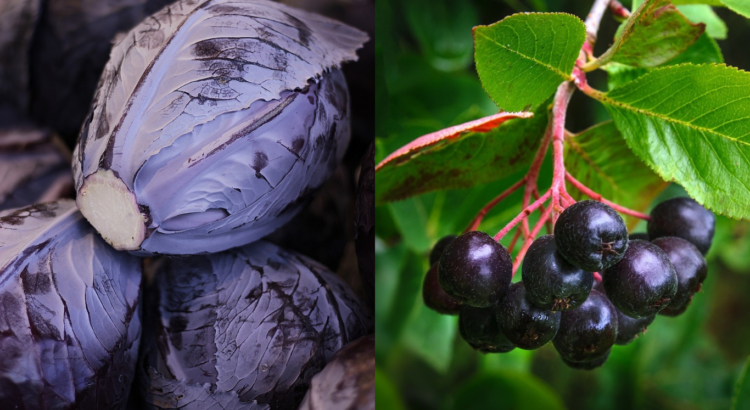Chokeberries and red cabbage owe their colour to anthocyanins, i.e. natural pigments which, in addition to their colouring properties, also have pro-health effects, including being powerful antioxidants. Researchers at our Institute have shown that these compounds cross the blood-cerebrospinal fluid barrier. This means that they can act beneficially in the environment of nerve cells, inhibiting processes leading, for example, to neurodegenerative diseases.
– Brain is an organ particularly susceptible to oxidative damage, which in turn can lead to neurological disorders such as strokes and neurodegenerative diseases (dementia, Alzheimer’s and Parkinson’s diseases). Consumption of antioxidant compounds such as anthocyanins can be a preventive measure. We have shown for the first time that they cross the blood-cerebrospinal fluid barrier – points out Prof. Wiesław Wiczkowski, head of Metabolomics Laboratory.
IMBALANCE
The starting point for his team’s research was the desire to expand our knowledge of the absorption, metabolism, distribution and excretion of anthocyanins present in food, including the possibility that these natural pigments and their metabolites – once ingested – reach the brain.
The second reason was the increasing number of scientific reports on the negative impact of modern society’s lifestyle – full of stress, lack of physical activity and poor diet. This contributes to increased levels of oxidative stress, which is characterised by an imbalance between oxidants (harmful free radicals when present in excess) and antioxidants (neutralising the former).
This state can lead to many diseases and a faster ageing of the body. The brain is also affected, as it is particularly sensitive to oxidative damage due to its high oxygen utilisation rate and high levels of unsaturated fatty acids.
As a preventive measure, scientists recommend the consumption of biologically active compounds with strong antioxidant properties. These include anthocyanins – natural pigments found in chokeberries and red cabbage.
However, in order for these compounds to have a chance to bring a beneficial effect to nerve cells, they must 'enter’ the nerve cell environment, e.g. the cerebrospinal fluid. For this to happen, they have to pass one of the barriers (blood-brain or blood-cerebrospinal fluid) that are designed to protect the central nervous system from toxic substances, among other things.
BREAK THROUGH
Researchers from the Institute have examined this and showed that anthocyanins from chokeberries and red cabbage can cross this barrier.
– We have shown that anthocyanins cross the cerebrospinal fluid and may therefore, theoretically, take part in all processes happening in the environment of nerve cells, especially those limiting oxidative processes – reports Prof. Wiczkowski.
Out of more than 600 anthocyanins present in the plant kingdom, the researchers investigated several forms of cyanidin – the most common form of anthocyanins. The cyanidin derivatives selected for the study had different structures (resulting from their combination with various sugars and phenolic acids; the more such combinations, the greater the structure of the compound).
– In addition to checking whether anthocyanins cross the barrier, we also wanted to see if and what role the molecular size and type of attached substituents (i.e. sugars and phenolic acids) play in this process. It turned out that the barrier crossing of anthocyanins is indeed determined by the molecular weight of these pigments and the type of substituents – explains the scientist.
The concentration of anthocyanins in the cerebrospinal fluid was detected at nanomol (10-9 mole) levels. – Therefore, further studies are needed to verify whether antioxidant mechanisms will occur at such low concentrations – he adds.
Wiesław Wiczkowski argues that, regardless of this last point, it is still a good idea to consume plenty of fresh fruits and vegetables, especially those rich in anthocyanins (i.e. those of blue, purple, red and orange colours).
– A regular intake of anthocyanins also benefits the composition of our microflora, the functioning of our eyesight and numerous organs. Importantly, no negative effects of these pigments have been demonstrated so far – concludes the scientist.
—
The research work was carried out within the framework of the already completed project entitled 'Studies on the permeation of anthocyanins and their metabolites across brain barriers in the context of prevention strategies for neurodegenerative diseases’, funded by the National Science Centre, whose initiator and manager was Prof. Wiesław Wiczkowski. For more details, see the scientific publications available below:
Chokeberry anthocyanins and their metabolites ability to cross the blood-cerebrospinal fluid barrier
—
The research formed the core of Dr. Natalia Płatosz’s PhD thesis (under the supervision of Prof. Wiesław Wiczkowski), for which she was awarded the prestigious 'START’ scholarship for young scientists by the Foundation for Polish Science in 2023. Read more.
